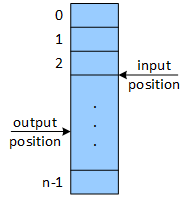

Random and direct access are synonyms, reflecting different aspects of the same I/O operations. As applied to file I/O, "random" doesn't imply "unpredictable," instead, it means "in any order." "Direct" suggests that a program can "directly" read or write any block of data without moving through the file sequentially. Programs build random or direct operations on top of the block I/O functions.
It's convenient to visualize a file as a contiguous sequence of blocks where each block represents a unit of data, often an instance of a structure or class, and numbers or indexes them sequentially. The block numbers are logical features of a problem that the program must map to the physical addresses the hardware "understands." The physical addresses are offsets, measured in bytes, from a specified file location:
offset = block number × block size
The UML class diagram of the C++ I/O stream classes presented at the beginning of the chapter shows that the ios class has a buffer named filebuf. All the leaf subclasses, ifstream, ofstream, and fstream inherit the buffer. However, iostream, and therefore fstream, has two superclasses and inherits a buffer from both. Consequently, an fstream object has two buffers and two position pointers.
Previous examples relied on streams that could read or write data, but not both. fstream objects can perform both operations, making it necessary for a program to specify carefully which position pointer it uses. Programs distinguish the two pointers as "get" (read or input) and "put" (write or output). In preparation for accessing a specific data item, the program moves the appropriate pointer within a file with one of four overloaded "seek" functions. The next I/O operation occurs at the new position in the file. Additionally, two "tell" functions report a stream's current position within a file. The name of each function ends with either a "p" or "g," denoting one of the pointers.
| Function | Description |
|---|---|
istream& seekg(streampos pos); |
Moves the "get" or "put" stream position to an absolute location, pos, in the file. Absolute positions are offset in bytes from the beginning of the file; pos must be ≥ 0. |
ostream& seekp(streampos pos); |
|
istream& seekg(streampos off, seekdir loc); |
Moves the "get" or "put" stream position to a location relative to one of three file locations. The offset, off, is the number of bytes added to or subtracted from the specified location, loc, is denoted by one of the symbolic constants:
off = current position + offset ≥ 0. It's possible but rarely useful to seek beyond the file's end, so off = current position + offset ≤ file size. |
ostream& seekp(streampos off, seekdir loc); |
|
streampos tellg(); |
Returns the current position of one of the position pointers within the file. The returned position is measured in bytes from the beginning of the file. Both functions return -1 on failure. |
streampos tellp(); |
| Function | Description |
|---|---|
ostream& flush() |
Forces the output stream to write any pending data in its buffer to the associated file. |
void clear() |
Clears or resets to 0 eofbit and all error flags. |
bool is_open() const; |
Returns true if the file associated with the stream is open; returns false otherwise. |
Programs can group bytes together forming blocks or records and read and write block-oriented files sequentially. They implement direct access by combining block I/O with the file positioning functions to read and write records. Programs specify the "seek" functions' offset value in bytes. However, a file of records appears and behaves like an array of objects, so it's more convenient for programmers to think of positioning operations in the problem-oriented terms of block numbers or indexes. Programmers must map a record, block number, or index to a byte offset within the file. Unfortunately, C++ doesn't have an appropriate library function, forcing programmers to implement the operation themselves.
struct chunk { . . . };
streampos offset = record * sizeof(chunk);
int record = offset / sizeof(chunk);
(b)offset = 7 * 10 = 70 record = 70 / 10 = 7(c)

struct chunk { . . . };
chunk c;
int n; // a block number / index
fstream data;
|
Specification and definitions for the examples. |
data.seekp(0, ios::end); data.write((char *) &c, sizeof(chunk)); |
Append a new record at the end of the file. |
data.seekg(0); data.read((char *) &c, sizeof(chunk)); |
Rewind to the beginning of the file and read the first record. |
data.seekg(0); while (data.read((char *) &c, sizeof(chunk))) .... |
Rewind to the beginning of the file and read all records in sequence. |
// read a record (perhaps in a loop) data.seekp(data.tellg() - (streampos)sizeof(chunk)); //data.seekp(ios::cur, -(streampos)sizeof(chunk)); // alt data.write((char *) &c, sizeof(chunk)); |
Searching and replacing - seek to the position after the last read, backup one record, and overwrite the record that's already there. The illustrated typecasts are required. |
data.seekg(n * sizeof(chunk)); data.read((char *) &c, sizeof(chunk)); // modify c data.seekp(n * sizeof(chunk)); data.write((char *) &c, sizeof(chunk)); |
Updating a record or block. Seek (move) to record number n. Read and modify the record. Seek to the same number and write the modified record, overwriting the old version. |
data.seekp(0, ios::end); // (a) streampos pos = data.tellp(); data.write((char *) &c, sizeof(chunk)); . . . data.seekg(pos); // (b) data.read((char *) &c, sizeof(chunk)); . . . data.seekp(pos); // (c) data.write((char *) &c, sizeof(chunk)); |
Simple database operations. Groups of code are separated by time. The variable pos may be a field in another object.
|